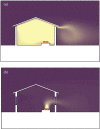Recommendations for building out mosquito-transmitted diseases in sub-Saharan Africa: the DELIVER mnemonic
- PMID: 33357059
- PMCID: PMC7776930
- DOI: 10.1098/rstb.2019.0814
Recommendations for building out mosquito-transmitted diseases in sub-Saharan Africa: the DELIVER mnemonic
Abstract
In sub-Saharan Africa, most transmission of mosquito-transmitted diseases, such as malaria or dengue, occurs within or around houses. Preventing mosquito house entry and reducing mosquito production around the home would help reduce the transmission of these diseases. Based on recent research, we make key recommendations for reducing the threat of mosquito-transmitted diseases through changes to the built environment. The mnemonic, DELIVER, recommends the following best practices: (i) Doors should be screened, self-closing and without surrounding gaps; (ii) Eaves, the space between the wall and roof, should be closed or screened; (iii) houses should be Lifted above the ground; (iv) Insecticide-treated nets should be used when sleeping in houses at night; (v) houses should be Ventilated, with at least two large-screened windows to facilitate airflow; (vi) Environmental management should be conducted regularly inside and around the home; and (vii) Roofs should be solid, rather than thatch. DELIVER is a package of interventions to be used in combination for maximum impact. Simple changes to the built environment will reduce exposure to mosquito-transmitted diseases and help keep regions free from these diseases after elimination. This article is part of the theme issue 'Novel control strategies for mosquito-borne diseases'.
Keywords: built environment; dengue; housing; malaria; sub-Saharan Africa.
Conflict of interest statement
We declare we have no competing interests.
Figures





References
-
- WHO. 2017. Global vector control response 2017–2030. Geneva, Switzerland: WHO; See https://www.who.int/vector-control/publications/global-control-response/en/.
-
- WHO. 2019. World malaria report. Geneva, Switzerland: WHO; See https://www.who.int/publications-detail/world-malaria-report-2019.
Publication types
MeSH terms
Grants and funding
- BB/R00532X/1/BB_/Biotechnology and Biological Sciences Research Council/United Kingdom
- MR/M007383/1/MRC_/Medical Research Council/United Kingdom
- MR/N011570/1/MRC_/Medical Research Council/United Kingdom
- MR/N011570/2/MRC_/Medical Research Council/United Kingdom
- G0400031/MRC_/Medical Research Council/United Kingdom
LinkOut - more resources
Full Text Sources
Medical
